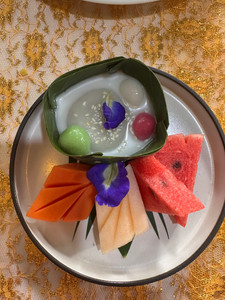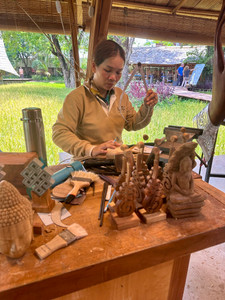Our Asian Adventure: Siem Reap, Cambodia - I’m Smitten, Part 2: come for the temples but stay for the rest
- debbiemanderson1
- Mar 19
- 6 min read
Updated: Mar 20

Millions of tourists flock to Siem Reap each year to see the Angkorian temples which is certainly enough reason to visit (please read my blogpost ‘Our Asian Adventure: Siem Reap, Cambodia - I’m Smitten, Part 1: an amazing hotel and even more amazing temples’); but there is so much local ambience to give you the trip of a lifetime.
First, let’s talk about that food. I had no idea that Siem Reap could be a foodie destination. (That is probably one of those misguided stereotypes you make when you know nothing about where you are going.) As we were to find out in our three day stay, Siem Reap provides a fusion of traditional Khmer, Asian, French, and western cuisine. There are so many food experiences - from your hotel to world class restaurants to street vendors to day or night markets. Siem Reap might not currently have any Michelin restaurants, but it has attracted world class chefs - and that might be the little old lady at the side of the road who can cook up something mighty tasty out of basic ingredients.
I can guarantee this street food tastes as good as a 5-star restaurant.

Our first hint of food quality came on our first day. After visiting three temples, we were then treated to lunch prepared by our hotel chef at a private residence near the village of Preah Dak. We marvelled at how the chef and his staff transported the food from the hotel kitchens to cook in this remote area. The setting was beautiful, and the food was exquisite. The Cambodians really know food presentation with lots of banana leaves, flowers, and fresh fruit. Oh, that fresh fruit!
The setting was tranquil, and there were some traditional fishing and rice harvesting artifacts to view.
The chef and one of our favourites, ‘Sam’:

The pieces de resistance:
There will be much more about food later, I guarantee.
One of the must-not-miss experiences in Siem Reap is a visit to a floating village on the surprising Tonle Sap or ‘great lake’ or ‘fresh river’. Tonle Sap is the largest freshwater lake in Southeast Asia with a maximum length of 250 kms and maximum width of 100 kms. It is a UNESCO ‘biosphere reserve’ and is home to fish, birds, reptiles, and plants. It is worth researching if you are interested. Tonle Sap has always been an important fishing and agricultural area for Cambodia. It is also unique for it’s ’floating villages’, traditional fishing villages that date back centuries and which simply adapt to the rising and falling water levels in order to continue their traditional fishing and agricultural practices. Due to monsoons and the flow of the Mekong River, the lake can rise 10 metres, and the nearby area is flooded. Houses and businesses are built high on stilts or on floating platforms to accommodate the rising water during rainy season which is roughly from June to October. There are several such floating villages, the most popular being Chong Kneas, Kompong Phluk, and Kompong Khelang. We hopped in the van for the 45 minute drive down a somewhat sticky red dirt road to Kompong Phluk, the closest to Siem Reap and unique for being on or near a mangrove forest which is a special feature of Tonle Sap lake. As travellers, you do have to pay an admission fee (again all taken care of by our efficient guide Sinet). I believe the entrance fee is about $20 American per person. This is a good source of income for these remote villages.
As we travelled to Siem Reap in March, Tonle Sap was low, so a road took us all the way to the village of Kompong Phluk where we boarded an old boat that took us past rows of houses on stilts, through a narrow waterway past mangrove forests, and out into the lake. In the wet season, you would need a boat just to get to and through the village. Residents travel from place to place by small boats, even the school children as they attend a ‘floating school’. So, in the wet season, it looks like a floating village and in the dry season, it looks like an entire village on stilts - all mesmerizing.
Our visit to Kompong Phluk was unique and one we might never see again. The photos were spectacular. Here you can see how high the houses are - and how high the water rises in the wet season. You can also see the mangrove forests and men engaging in traditional fishing. Apparently, a traditional practice due to religious beliefs is to catch the fish alive and let them die naturally.
Once we reached Tonle Sap, we passed fishing boats on our way to a floating restaurant complete with it’s own crocodiles, cats, turtles, and baby chicks.


On our way back through Kompong Phluk, we stopped at the floating/elevated school to drop off books and pencils. The children were all so polite and stood and sung a song for us. Their shoes were all neatly lined up outside the door. A good article about floating schools is “Living and learning on the Tonle Sap Lake”(unicef.org)


I will never forget our trip to Kompong Phluk.
Part of our package at the Golden Temple Hotel was a set-menu lunch and dinner. After our morning at Kompong Phluk, we decided to have our free lunch at Mealea, one of the Golden Temple chain’s ’sister’ restaurants. This was another great Cambodian food adventure.
We spent a pleasant afternoon visiting Siem Reap’s artisan ‘incubator’, Satcha, where young people learn a traditional skill which can be translated into entrepreneurship and self-sufficiency in the future. The organization’s mission is to maintain heritage but with a modern twist while contributing to independence. Some of the skills are wood working, painting, carving, and silk weaving. There is a classy store and a delightful cafe on site. The grounds are beautiful.
What would a visit to a foreign country be without a food tour? Siem Reap didn’t disappoint here, either. We piled into tuktuks for our first tuktuk ride to sample authentic Siem Reap cuisine. (Tuktuks are a legitimate mode of transport.)

First up were noodles and chive cakes. So good.
Next was a type of omelette, a very thin egg batter stuffed with sprouts in which you rolled a mixture of the freshest lettuce and leaves and herbs . . .my favourite of the foodie tour. I love their use of curry and lime leaves, lemongrass, basil, cilantro . . .
Third up was traditional soup, again with the biggest bowl of fresh greens to add in at will.
Next was a speciality - crunchy bugs at the locals’ night market. Our assessment was that roasted spiced crickets are good, larvae are too chewy, and tarantula legs are tough. Here are pictures of the variety of insects for sale. Truthfully, though, they had nice seasonings such as salt, pepper, sugar, hot spice, etc. I imagine they are eaten much like potato chips at home. We just haven’t acquired the taste.
I might have been just a little dramatic . . .
But Sinet, our guide, was all in . . . and bought a bag for one of his fellow guides back at the hotel.

The ambience at the night market was like something out of National Geographic with a big red moon, people visiting and small motorbikes racing down the street. I will never forget this evening.


Speaking of night action, if you want to go clubbing or just leisurely strolling, or maybe get a special type of pedicure, you can head to Pub Street in downtown Siem Reap. We walked through one night, but it isn’t our ‘thing’. I am sure you can find pretty much anything you want there . . . those are not our feet, by the way.


On a more sombre note, one of the sad realities of Cambodia was that millions of Cambodians lost their lives due to the Khmer Rouge regime and civil war. Many others were left incapacitated. It is not uncommon to see groups of people often playing music as a means of securing an income. They were victims of landmines. Cambodia is known to be one of the most landmine-infested countries in the world. Although large attempts have been made to find and destroy buried explosives, it is estimated that thousands still exist. Interestingly, rats are trained to sniff out landmines or other remnants of explosives for destruction, and we could have toured a museum explaining this but chose not to do so.

Cambodia is truly a dichotomous place, and our final adventure in Siem Reap was a night we all agreed was magical - a sunset boat cruise past the ancient city of Angkor Thom. At about 5:30 pm, we boarded two dragon boats at the south entrance to the old ruins where we were greeted with drinks and, of course, more amazing traditional food prepared by the Golden Temple Hotel. We moved along a serene waterway with the strength of one oarsman and waited until the sun set for amazing sunset photos. The sights, the smells, and the quietness were intoxicating. A special memory.


But there was time for one final foodie experience at the Golden Temple Hotel before we departed the next morning.
So, Siem Reap, Cambodia, is definitely worth visiting just for the temples, but throw in some local excursions, some culture, and some amazing food (roasted bugs or not), and you will have the adventure of a lifetime, I promise. I was smitten.
Thanks for reading. Please check back in a few days when we visit Phnom Penh.






































































































































































All I can say is WOW !! Such an amazing blog about a country that we know nothing about.
You did such an amazing job explaining everything !! So, so very interesting.